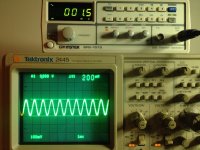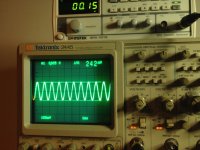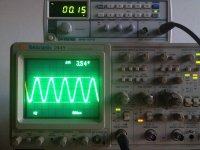Here are two measurements I made.
First: 40 dB attenuation set on generator resulting in 1.5 mV generator output. The phono output is what I could call having flickering peaks.
Second, no -40 dB preset, 150 mV setting, an L–Pad in-between gen and DUT instead. (10K–100 Ohms). Stable waveform on phono out.
First: 40 dB attenuation set on generator resulting in 1.5 mV generator output. The phono output is what I could call having flickering peaks.
Second, no -40 dB preset, 150 mV setting, an L–Pad in-between gen and DUT instead. (10K–100 Ohms). Stable waveform on phono out.
Attachments
Means that the internal attenuator is not as good as the physical external L-Pad for SNR or accuracy of division. OK its a budget gen but not many are great in mV.
Maybe the attn is realized in the DDS domain so its just jitter or some internal route is noisier not helping the few mV range. Still helpful for quick checks even that low.
This gen always displays Vp-p for 50 Ohm lab standard, that means 3mV pk-pk signal across high Z 10K pad i.e. 242/3=38dB gain only. Say 40dB max if the gen's voltmeter has highish tolerance. Given that you got >1K input load resistor in your Pearl not overloading the pad, then something's not working properly or its simply wrongly set for MM mode instead of MC.
Maybe the attn is realized in the DDS domain so its just jitter or some internal route is noisier not helping the few mV range. Still helpful for quick checks even that low.
This gen always displays Vp-p for 50 Ohm lab standard, that means 3mV pk-pk signal across high Z 10K pad i.e. 242/3=38dB gain only. Say 40dB max if the gen's voltmeter has highish tolerance. Given that you got >1K input load resistor in your Pearl not overloading the pad, then something's not working properly or its simply wrongly set for MM mode instead of MC.

 That's crazy and probably looks like a silly thing overlooked by me. But I admit I don't understand the use of 1M vs 50 Ohm. I though lowest input impedance is the way to go here. AC coupling should remove DC offset right? Sounds like a right thing to do here, hehe. Silly, silly me...
That's crazy and probably looks like a silly thing overlooked by me. But I admit I don't understand the use of 1M vs 50 Ohm. I though lowest input impedance is the way to go here. AC coupling should remove DC offset right? Sounds like a right thing to do here, hehe. Silly, silly me...I'll retest again this evening.
Thanks for helping me out with all this stuff.
50 Ohm lab standard is to match impedance correctly between lab equipment and lab coax so to avoid reflections in transfer of fast edges and keep gen levels as stated. You need to select 1Meg AC (or DC if you want to monitor offset) when measuring some DUT not designed to drive 50 Ohm. Also never drive more than 5V RMS to the Tek when in 50 Ohm mode. It has no more than 0.5W absorption capability in that mode and its going to suffer burn out damage for that input setting if overdriven.
Beautiful output at 1.5 mV input.
3.5 Vpp means around 66 dB of gain.
Am I correct?
The clipping is symmetrical at 22.3 mV input
Not quite correct. 3540/3=61.44dB gain. Because what Vp-p you see on the gen voltmeter corresponds to double when driving high Z. What you see is what you get only when its driving a matched 50 Ohm load. If you want preciser readings crosscheck for RMS out/in with your DMM too. Anyway, measuring method problem solved. You had definitely been overloading the Pearl's output before.
On one channel DC offset is in between -30 mV and 30 mV. While on the other it's more wild, going from -100mV to +100mV sometimes. Should I battle? If yes, how?
I don't know, the Pearl experts may guide you on that. This is not passing through the output coupling capacitor though. Right?
Anyway, measuring method problem solved.
Thank you,
 Salas. That's already a lot for me. I need to gain more knowledge about input output impedances between measuring devices, that's for sure.
Salas. That's already a lot for me. I need to gain more knowledge about input output impedances between measuring devices, that's for sure.Output coupling cap passes about -20 to 20 mV DC on both channels.
The DCB1 will pass it through. And if the power amp is DC input coupled too, its certainly not a good thing. It will amplify it to the speakers by its voltage gain. i.e. a times 20 (26dB) power amp will present 400mV to the speakers for 20mV on its inputs and so on and so forth. That can even disrupt the magnetic centering. To make it even worse, if the DC offset is periodic i.e. changes in a few HZ cycle you will also see the tell tale woofer pumping thing that tubes diy people sometimes see when a passive HV PSU has bad charge timing to the circuit and the couplings.
Output coupling cap passes about -20 to 20 mV DC on both channels.
Is Ground reference ok ? Do you have propre earth scheme in mains ?
Best,
 Hello, Anaël
Hello, AnaëlI guess it's "assez propre". Worked mighty silent before replacing gain resistance. Grounding schematic copied from 6l6 except couple of things: ground loop breaker before PSU and well
6L6 grounding
PS. Earth is fine in my house.
- Home
- Amplifiers
- Pass Labs
- Pearl Two



